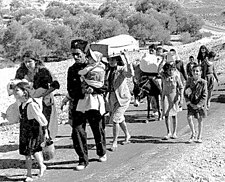Palestinian refugee camps
This article relies largely or entirely on a single source. (September 2016) |
 |
| Part of a series on the |
| Nakba |
|---|
Palestinian refugee camps were established after the 1948 Arab–Israeli War to accommodate the Palestinian refugees who fled or were expelled during the 1948 Palestinian exodus. United Nations General Assembly (UNGA) Resolution 194 grants Palestinians the right to return to their homeland if they wish to "live at peace with their neighbors".
The United Nations Relief and Works Agency for Palestine Refugees in the Near East (UNRWA) defines a Palestinian refugee as:
- "persons whose normal place of residence was Palestine during the period 1 June 1946 to 15 May 1948, and who lost both home and means of livelihood as a result of the 1948 conflict."
In the context of the Arab-Israeli conflict, Jewish refugees who fled or had been expelled during the Jewish exodus from Arab and Muslim countries were initially resettled in refugee camps known variously as Immigrant camps, Ma'abarot, and "development towns" prior to absorption into mainstream Israeli society. Conversely, many Palestinian refugees remain in Palestinian refugee camps, while others have been absorbed into Jordanian society or the Palestinian territories.
Role of UNRWA
UNRWA recognizes facilities in 59 designated refugee camps in Jordan, Lebanon, Syria, the West Bank and the Gaza Strip. It also provided relief to displaced persons inside Israel following the 1948 conflict until the Israeli government took over responsibility for them in 1952.
For a camp to be recognized by UNRWA, there must be an agreement between the host government and UNRWA governing use of the camp. UNRWA does not itself run any camps, has no police powers or administrative role, but simply provides services to the camp. Designated refugee camps, which developed from tented cities to rows of concrete blockhouses to urban ghettos indistinguishable from their surroundings (effectively becoming urban developments within existing cities or by themselves), house around one third of all registered Palestine refugees. UNRWA also provides facilities in other areas where large numbers of registered Palestine refugees live outside of recognized camps.
UNRWA defines a Palestine refugee as:[1]
- "persons whose normal place of residence was Palestine during the period 1 June 1946 to 15 May 1948, and who lost both home and means of livelihood as a result of the 1948 conflict."
UNRWA's definition of a refugee also covers the descendants of refugee males.[1] The number of registered Palestine refugees (PR) has subsequently grown from 750,000 in 1950 to around 5 million in 2013.[1]
List of camps
This lists the current Palestine refugee camps with current population and year they were established.[2]
Gaza Strip
The Gaza Strip has 8 refugee camps and 1,221,110 registered refugees.
- 1948, Al-Shati (Beach camp), 87,000
- 1949, Bureij, 34,000
- 1948, Deir al-Balah Camp, 21,000
- 1948, Jabalia Camp, 110,000
- 1949, Khan Yunis Camp, 72,000
- 1949, Maghazi, 24,000
- 1949, Nuseirat Camp, 66,000
- 1949, Rafah Camp, 104,000
West Bank
The West Bank has 19 refugee camps and 741,409 registered refugees. One camp is unofficial (*).
- 1948, Aqabat Jaber, 6,400
- 1948, Ein as-Sultan, 1,900
- 1948, Qaddura camp*, 1,558
- 1949, Far'a, 7,600
- 1949, Fawwar, 8,000
- 1949, Jalazone, 11,000
- 1949, Kalandia, 11,000
- 1949, Am'ari, 10,500
- 1949, Deir 'Ammar Camp, 2,400
- 1949, Dheisheh, 13,000
- 1950, Aida, 4,700
- 1950, Al-Arroub, 10,400
- 1950, Askar, 15,900
- 1950, Balata, 23,600
- 1950, 'Azza (Beit Jibrin), 1,000
- 1950, Ein Beit al-Ma' (Camp No. 1), 6,750
- 1950, Tulkarm camp, 18,000
- 1952, Nur Shams, 9,000
- 1953, Jenin camp, 16,000
- 1965, Shuafat camp, 11,000
Syria
Syria has 13 refugee camps and 499,189 registered refugees. Three of these camps are unofficial (*).
- 1948, Sbeineh, 22,600
- 1949, Khan Eshieh, 20,000
- 1948, Neirab, 20,500
- 1949, Homs, 22,000
- 1948, Jaramana camp, 18,658
- 1950, Deraa camp, 10,000
- 1950, Hama camp, 8,000
- 1950, Khan Dannun, 10,000
- 1967, Qabr Essit, 23,700
- 1955-6, Latakia Camp*, 10,000
- 1957, Yarmouk*, 148,500
- 1962, Ein Al-Tal*, 6,000, also known as Handarat camp
Lebanon
There are 12 refugee camps in Lebanon and 448,599 registered refugees.
- 1948, Bourj el-Barajneh, 17,945
- 1948, Ain al-Hilweh, 54,116
- 1948, El Buss, 11,254
- 1949, Nahr al-Bared, 5,857
- 1949, Shatila, 9,842
- 1948, Wavel, 8,806
- 1952, Mar Elias, 662
- 1954, Mieh Mieh, 5,250
- 1955, Beddawi, 16,500
- 1955, Burj el-Shemali, 22,789
- 1956, Dbayeh camp, 4,351
- 1963, Rashidieh, 31,478
Jordan
There are 10 refugee camps in Jordan and 2,034,641 registered refugees.
- 1949, Zarqa camp, 20,000
- 1952, Jabal el-Hussein, 29,000
- 1955, Amman New Camp (Wihdat), 51,500
- 1967, Souf, 20,000
- 1968, Baqa'a, 104,000
- 1968, Husn (Martyr Azmi el-Mufti camp), 22,000
- 1968, Irbid camp, 25,000
- 1968, Jerash camp, 24,000
- 1968, Marka, 53,000
- 1968, Talbieh, 7,000
See also
References
- ^ a b c "Who We Are - UNRWA". UNRWA. Retrieved 8 January 2014.
- ^ "Where We Work - UNRWA". UNRWA. Retrieved 8 January 2014.
External links
- The Empire Files: Inside Palestine's Refugee Camps (October 2016), Abby Martin for The real news network and TeleSUR. A video report from the Balata and Aida camps in the West Bank (30 minutes).
- Palestinian Refugees in Lebanon
- Palestinian Refugees in Syria
- Palestinian Refugees in Jordan
- As rebuilding begins at lebanon's nahr al bared, displaced refugees are eager to return, William Wheeler and Don Duncan, World Politics Review, 11 March 2008
- UN refugee agency unveils Palestinian archive
